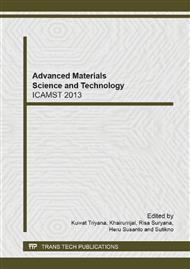p.681
p.687
p.695
p.701
p.706
p.710
p.714
p.718
p.722
Design and Fabrication of Wear Testing Machine for a Fishing Net-Weaving Machine Component
Abstract:
A hook is an important fishing net-weaving machine component that is used for making fishing net. During the production of fishing net, nylon fiber is in continuous contact with the hooks by sliding on the inner curve of the hooks that results in wear on the hooks. Weight loss of the hooks as the wear resistance measurement was collected to investigate the surface quality of the hooks. Presently, a wear testing machine for a fishing net-weaving machine component is not available for wear resistance study. Thus this work aimed to design and fabricate a wear testing machine that has a mechanism as similar to the actual working conditions as possible and so can provide accurate testing data. It has been proven that the wear testing machine built as a result of this study gave wear testing results extremely similar to those when testing on the actual fishing net-weaving machine.
Info:
Periodical:
Pages:
706-709
Citation:
Online since:
February 2014
Price:
Сopyright:
© 2014 Trans Tech Publications Ltd. All Rights Reserved
Share:
Citation:


